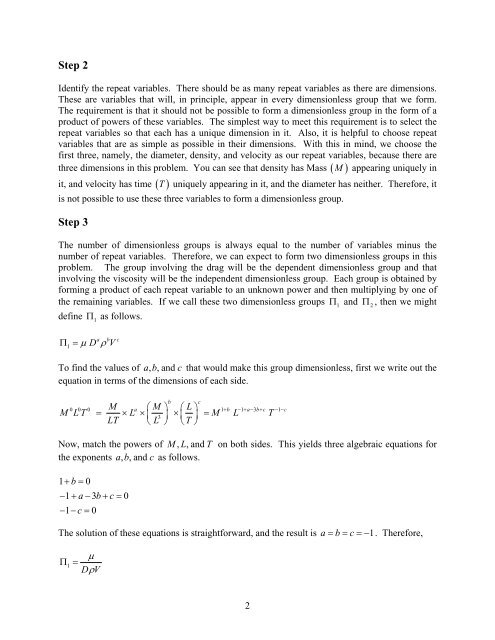Dimensional Analysis – Drag on a Sphere R. Shankar Subramanian
Dimensional Analysis – Drag on a Sphere R. Shankar Subramanian
Dimensional Analysis – Drag on a Sphere R. Shankar Subramanian
You also want an ePaper? Increase the reach of your titles
YUMPU automatically turns print PDFs into web optimized ePapers that Google loves.
Step 2<br />
Identify the repeat variables. There should be as many repeat variables as there are dimensi<strong>on</strong>s.<br />
These are variables that will, in principle, appear in every dimensi<strong>on</strong>less group that we form.<br />
The requirement is that it should not be possible to form a dimensi<strong>on</strong>less group in the form of a<br />
product of powers of these variables. The simplest way to meet this requirement is to select the<br />
repeat variables so that each has a unique dimensi<strong>on</strong> in it. Also, it is helpful to choose repeat<br />
variables that are as simple as possible in their dimensi<strong>on</strong>s. With this in mind, we choose the<br />
first three, namely, the diameter, density, and velocity as our repeat variables, because there are<br />
three dimensi<strong>on</strong>s in this problem. You can see that density has Mass ( M ) appearing uniquely in<br />
it, and velocity has time ( T ) uniquely appearing in it, and the diameter has neither. Therefore, it<br />
is not possible to use these three variables to form a dimensi<strong>on</strong>less group.<br />
Step 3<br />
The number of dimensi<strong>on</strong>less groups is always equal to the number of variables minus the<br />
number of repeat variables. Therefore, we can expect to form two dimensi<strong>on</strong>less groups in this<br />
problem. The group involving the drag will be the dependent dimensi<strong>on</strong>less group and that<br />
involving the viscosity will be the independent dimensi<strong>on</strong>less group. Each group is obtained by<br />
forming a product of each repeat variable to an unknown power and then multiplying by <strong>on</strong>e of<br />
the remaining variables. If we call these two dimensi<strong>on</strong>less groups Π 1 and Π2<br />
, then we might<br />
define Π as follows.<br />
Π =<br />
1<br />
1<br />
a b c<br />
μ D ρ V<br />
To find the values of ab , ,andcthat<br />
would make this group dimensi<strong>on</strong>less, first we write out the<br />
equati<strong>on</strong> in terms of the dimensi<strong>on</strong>s of each side.<br />
b c<br />
0 0 0 M a ⎛M ⎞ ⎛ L⎞<br />
1+ b −+ 1 a− 3b+ c −− 1 c<br />
= × × × =<br />
3<br />
M LT L ⎜ ⎟ ⎜ ⎟ M L T<br />
LT ⎝ L ⎠ ⎝T⎠ Now, match the powers of M , L, and T<br />
the exp<strong>on</strong>ents ab , , and cas<br />
follows.<br />
1+ b = 0<br />
− 1+ a− 3b+<br />
c=<br />
0<br />
−1− c = 0<br />
<strong>on</strong> both sides. This yields three algebraic equati<strong>on</strong>s for<br />
The soluti<strong>on</strong> of these equati<strong>on</strong>s is straightforward, and the result is a = b= c=−<br />
1.<br />
Therefore,<br />
μ<br />
Π 1 =<br />
DρV 2

















